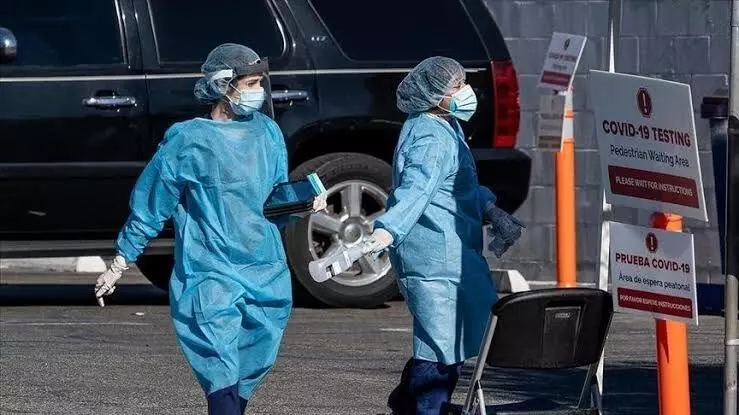Covid resurgence: WHO releases risk assessment; India asks people to remain cautious
Crucially, there is no evidence to suggest NB.1.8.1 causes more severe illness
By Anoushka Caroline Williams
Representational Image
Hyderabad: World Health Organization (WHO) has released an updated risk assessment of the emerging SARS-CoV-2 variant NB.1.8.1, noting that while the variant is spreading rapidly, current data does not indicate increased disease severity.
Indian experts echo the WHO’s findings, advising the public to remain cautious but not alarmed.
NB.1.8.1 on the Rise Globally
According to WHO data, NB.1.8.1 now accounts for 10.7% of global COVID-19 sequences as of epidemiological week 17 (April 21–27, 2025), a significant rise from 2.5% just four weeks earlier. The Western Pacific Region (WPR) currently reports the highest proportion of this variant. Despite its growth, WHO categorizes the overall public health risk of NB.1.8.1 as low.
The variant shows a moderate growth advantage over other circulating Omicron sub-lineages but does not appear to increase hospitalization or mortality rates. “There are no reports to suggest that the associated disease severity is higher as compared to other circulating variants,” states the WHO report.
Immune Escape and Severity: Low Concern
Laboratory findings show that NB.1.8.1 exhibits slightly greater immune evasion than its predecessor LP.8.1. However, this difference is marginal. Pseudovirus testing showed only a 1.5–1.6 fold reduction in neutralization using plasma from individuals previously infected with BA.5 or JN.1 variants.
The variant carries spike mutations that reduce the potency of certain monoclonal antibodies, but no changes have been identified that would reduce the effectiveness of current antiviral drugs such as Nirmatrelvir, remdesivir, or molnupiravir.
Crucially, there is no evidence to suggest NB.1.8.1 causes more severe illness. According to WHO surveillance data, “routine clinical surveillance does not indicate any signs of increased severity,” and there are no increases in ICU admissions or all-cause mortality linked to this variant.
Expert Perspective: COVID-19 Now Part of Seasonal Respiratory Cycle
Dr. Kiran Madala, Professor of Critical Care Medicine at Gandhi Medical College, Secunderabad, speaking to Newsmeter, said the emergence of NB.1.8.1 should be seen in the context of COVID-19’s overall evolution.
“COVID-19 has never fully disappeared since its initial emergence in December 2019,” he said. “However, its clinical severity significantly declined following the emergence of the Omicron variant in 2022.”
Dr. Madala noted that while new sub-variants continue to appear, none so far have reversed the broader trend of milder illness. “COVID-19 has now effectively joined the family of seasonal respiratory viruses, contributing to 5–10% of respiratory infections, including in India,” he said, citing data from the WHO and the Indian Council of Medical Research (ICMR).
Public Guidance: Stay Cautious, Not Fearful
With several variants under monitoring globally, including NB.1.8.1, XFH, LF.9, and others, public health agencies are maintaining close genomic and clinical surveillance.
Dr. Madala advised the public to remain alert but not to panic. “The currently circulating variant, NB.1.8.1, falls under the mild category in terms of clinical impact,” he said. “The public is strongly advised not to panic. Instead, continued adherence to respiratory etiquette — such as mask-wearing in crowded spaces, hand hygiene, and self-isolation when symptomatic — remains essential.”
Conclusion
While the NB.1.8.1 variant is spreading more rapidly than previous sub-lineages, experts and global health bodies agree that it does not currently pose an elevated risk in terms of severity or treatment resistance. Ongoing surveillance and responsible public behavior remain key to managing the situation.